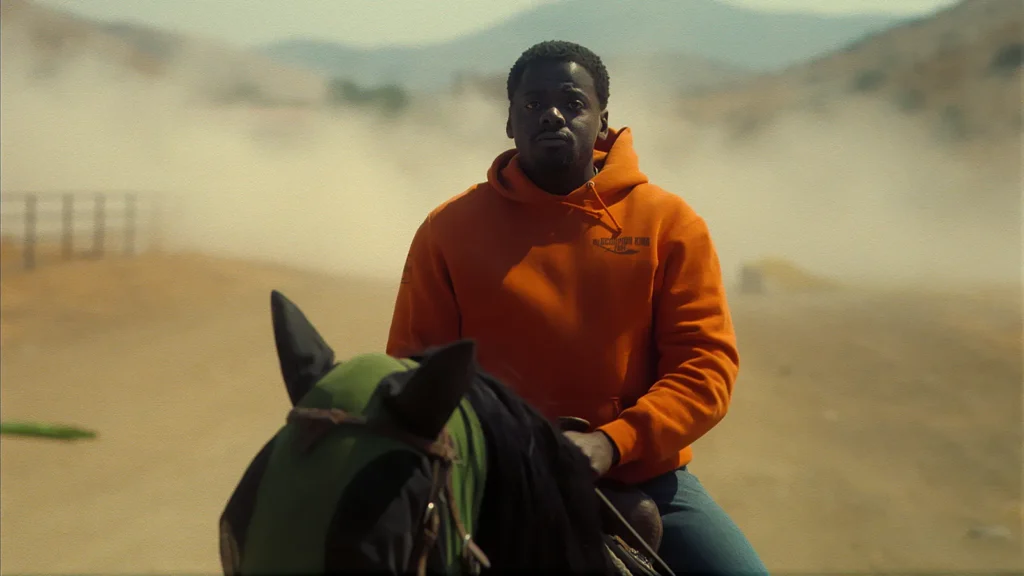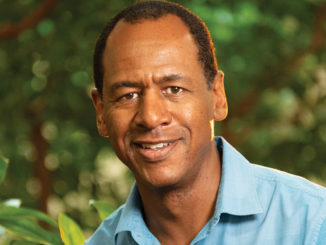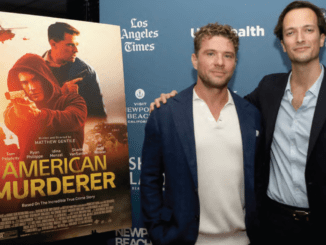
By Patrick Z. McGavin
Editor Nicholas Monsour is riding the zeitgeist with an ideal collaborator, Jordan Peele, the comic actor who rose to filmmaking fame with his thriller “Get Out” (2017).
A Los Angeles native, Monsour had also worked with Peele on his television sketch series, “Key and Peele” (2012-2015), as well as on “Keanu” (2016). And then the pair collaborated again on Peele’s second narrative feature, “Us” (2019).
Peele’s new feature, “Nope,” is another science fiction and horror hybrid about sibling heirs (Daniel Kaluuya and Keke Palmer) of a pioneering Black-owned horse farm who seek documentary evidence after a supernatural presence materializes over their ranch.
Note: Some spoilers may follow.
CineMontage: The film was shot largely on large-format IMAX cameras. What were the particular challenges, technically and artistically?
Nicholas Monsour: I had never worked in 70mm, 65mm, or IMAX. I had a little bit of experience with 35mm, where you’d use film for a very specific purpose.
Once the dailies were scanned and placed into the Avid, it was in many ways the same process that we were all used to with offline digital files.
They also developed a new process for capturing the night time film, using a mixture of night time footage, day for night footage, and infrared video footage. It basically turned every night time shot into a visual effects shot in order to go through a workflow.
There was definitely more imagination needed when looking at a scene to keep in mind how it was going to look.
CineMontage: How would you describe your working relationship with Jordan Peele?
Nicholas Monsour: One way that we relate well to each other is that we treat each project on its own terms. As the director he now is the person every question has to go through. He still invites everybody to bring their own take on the material.
With “Nope,” whether it’s the scripted or storyboarded version, I also had my alternate takes of my own hopefully objective version, as I perceive it.
Sometimes just to crack open a conversation and look at it from a different angle, I will try things I know are wrong or crazy, so that I might spark a new way of thinking about the tone.
Jordan loves the edit, and he loves trying all the variations. He also completely respects it if I’d say: “Look, give me two more days, and I will come up with something I think you are going to love.”

CineMontage: How did you come up with the idea of the film having chapter headings?
Nicholas Monsour: The chapter headings were his idea from the beginning, another way to communicate in a fun way that there is an intentional organization and withholding of information that serves a purpose.
The chapter headings remind you there is an author to what you’re watching. It also gives you a bit of a chill because you instinctively remember what happened the last time you saw one.
CineMontage: The prologue has a fascinating and terrifying use of foreshadowing?
Nicholas Monsour: An amazing thing about this project given all the constraints about shooting on this really expensive, intense camera format, all the visual effects, all the moving parts, was how Jordan took great pains to create worlds of sets and fleshed out characters.
The footage in the original edit of everything they shot was a much more expansive atmospheric thing where you could soak up all of these details. It was a process of finding the right moments to bring in these characters and details that were planted all over the place.
The chimpanzee prologue did get a lot of scrutiny because it’s the most intrusive and jarring edit points in the movie where we leave our chronology, and we leave our other characters’ point of view. You have to piece it together, and hopefully there is some mystery, and hopefully some unexpected turns.
It’s more about the deeper themes of the movie than the exact plot. It sets the audience’s expectations in a certain way to be conscious of these other themes, and it also prepares you for some of the darker turns and twists in the story.
CineMontage: Sound really shapes and dictates the rhythm, pace and tone of the storytelling.
Nicholas Monsour: With “Us,” we talked a lot about our approach to sound, but maybe we were not able to do so because there wasn’t the time or the freedom. On “Nope,” we talked about how the sound is telling more of the story than the imagery.
Jordan really intentionally bonded with supervising sound editor Johnnie Burn. Jordan started working with Johnnie immediately, to the point Johnnie had an entire sound mix movie before production even started. He created a scene by scene map using scene descriptions and previsualization.
A lot of it was totally thrown out as soon as the footage came in, and a lot of it stayed. The first scene on the ranch is a great example. There was a constant dance with the rain of debris, sound, visual effects, the edit and music all had to work together. Johnnie was able to put in a little bit of a map based on my initial trying to mark the spots that seemed the most important after we picked the takes. Johnnie was able to flesh it out, and then visual effects made sure the music was working right.
CineMontage: You negotiate a tricky tonal balance, especially with how humor offsets the dread and horror.
Nicholas Monsour: It goes without saying that Jordan’s sense of humor is world-famous. He is very good at identifying characters that I don’t feel like I have seen explored before in genre films. Jordan is very good at setting up scenarios where these particular characters’ idiosyncrasies play off each other.
We have an embarrassment of riches in the editing bay. Often he will come in after I have gotten close. He will give me that little bit of insight he has as a comedic performer and knowing how an audience responds to timing. He will take an edit I’ve done, and push it one last bit to get that double laugh.
CineMontage: The second half of the film features a lot of big set pieces and very extensive effects work. How did that complicate your creative input?
Nicholas Monsour: I think it varies from sequence to sequence. By and large, everyone treated the edit very respectfully because we knew it had to work cinematically, with or without massive visual effects. The pacing of a chase sequence or a dark scary room had to be scary or exciting with or without the effects there.
The edit stayed live as long as possible so as visual effects came in, we were able to test the timing, and sometimes just adjust a frame or two, and that would make a big difference for how the computer generated effects would play out.
It was definitely the most material I ever had to work with. There were discoveries made just by rifling through all the visual effects. The title sequence, for instance, was a later discovery.
It was also hair raising because of the schedule. We had to make sure we were not changing an edit too late for them to really address as early as they needed to with the visual effects.
CineMontage: The movie’s emotional centerpiece is the sibling relationship of Daniel Kaluuya and Keke Palmer. How would you describe your approach to shaping their contrasting characters and very different acting styles?
Nicholas Monsour: I had a bit of a theater and performance background before ever working in film. I feel like that was a great help.
You definitely learn more as you get to see more and more actors. You get to see takes, behind the scenes, and people preparing. I feel a great responsibility when I see the emotional, psychological and physical work that actors are doing. I work really hard trying to preserve the magic of what they’re doing. Sometimes that deviates from what was scripted.
I learn a lot from the script supervisor’s notes, and what the director tells the script supervisor. I try to look at the footage as objectively as I can, and then I will look and compare notes with what the director’s favorite take is, and that will tell me something about the kind of performance they want from that character.
You’re building a picture as you go. Sometimes it’s pretty obvious, and sometimes you have to not be swayed by an amazing performance that might not fit in the scene or movie. As Jordan has said, something that appears to be great on set might not work in context.
CineMontage: Was becoming an editor an intentional action, or more a provenance of happy accidents?
Nicholas Monsour: It seemed accidental, but in hindsight it looked pretty inevitable. I didn’t go to a traditional film school. I went to the School of the Art Institute in Chicago. My original interests in film were more obscure international and experimental filmmakers.
I’m also from Los Angeles, and my father John worked in 24-frame playback and computer playback on a lot of big movies. I was on sets growing up, like “Jurassic Park” (1993), “Apollo 13” (1995) and “Men in Black” (1997). I saw that part of filmmaking from a very specific technical crew angle. I always had interests in the different ways of making movies.
By the time I hit art school, there was this explosion of what video could do, especially with low budgets. You could make a film on mini-DV, and it could play in theaters and festivals.
I gravitated toward collaborating with people. Some people hated editing, and I loved it. The tactile part of it, dragging the clips around and making these collages of images, fit my personality pretty well. Without realizing it, I had done a lot of the experimenting in order to get good at it without really trying, and being able to help other people.
CineMontage: What’s the most satisfying part of the work?
Nicholas Monsour: You can’t force it, but when you bring an idea that nobody thought of yet that changes the meaning of a way scene works purely through the editing. They shot it one way, they wrote it one way, but it just turns out it works better if you pull this part out, and put it there, or you take this sound out, or the music out, and it works here, and that is an exhilarating part.
You have to always be trying to do what’s right. Ninety-nine percent of the time, it might be without your creative input. The one time it changes the project, that is really exciting. That’s a moment where you really feel like you’re earning your keep.
Patrick Z. McGavin is a Chicago-based critic and cultural journalist.





